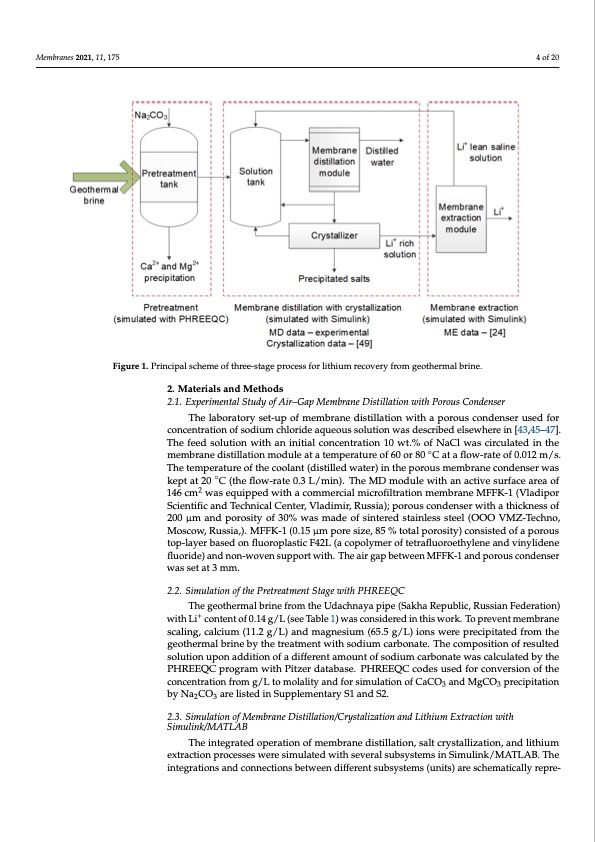
PDF Publication Title:
Text from PDF Page: 004
Membranes 2021, 11, 175 4 of 20 Figure 1. Principal scheme of three-stage process for lithium recovery from geothermal brine. 2. Materials and Methods 2.1. Experimental Study of Air–Gap Membrane Distillation with Porous Condenser The laboratory set-up of membrane distillation with a porous condenser used for concentration of sodium chloride aqueous solution was described elsewhere in [43,45–47]. The feed solution with an initial concentration 10 wt.% of NaCl was circulated in the membrane distillation module at a temperature of 60 or 80 ◦C at a flow-rate of 0.012 m/s. The temperature of the coolant (distilled water) in the porous membrane condenser was kept at 20 ◦C (the flow-rate 0.3 L/min). The MD module with an active surface area of 146 cm2 was equipped with a commercial microfiltration membrane MFFK-1 (Vladipor Scientific and Technical Center, Vladimir, Russia); porous condenser with a thickness of 200 μm and porosity of 30% was made of sintered stainless steel (OOO VMZ-Techno, Moscow, Russia,). MFFK-1 (0.15 μm pore size, 85 % total porosity) consisted of a porous top-layer based on fluoroplastic F42L (a copolymer of tetrafluoroethylene and vinylidene fluoride) and non-woven support with. The air gap between MFFK-1 and porous condenser was set at 3 mm. 2.2. Simulation of the Pretreatment Stage with PHREEQC The geothermal brine from the Udachnaya pipe (Sakha Republic, Russian Federation) with Li+ content of 0.14 g/L (see Table 1) was considered in this work. To prevent membrane scaling, calcium (11.2 g/L) and magnesium (65.5 g/L) ions were precipitated from the geothermal brine by the treatment with sodium carbonate. The composition of resulted solution upon addition of a different amount of sodium carbonate was calculated by the PHREEQC program with Pitzer database. PHREEQC codes used for conversion of the concentration from g/L to molality and for simulation of CaCO3 and MgCO3 precipitation by Na2CO3 are listed in Supplementary S1 and S2. 2.3. Simulation of Membrane Distillation/Crystalization and Lithium Extraction with Simulink/MATLAB The integrated operation of membrane distillation, salt crystallization, and lithium extraction processes were simulated with several subsystems in Simulink/MATLAB. The integrations and connections between different subsystems (units) are schematically repre-PDF Image | Process of Lithium Recovery from Geothermal Brine

PDF Search Title:
Process of Lithium Recovery from Geothermal BrineOriginal File Name Searched:
membranes-11-00175-v2.pdfDIY PDF Search: Google It | Yahoo | Bing
Product and Development Focus for Infinity Turbine
ORC Waste Heat Turbine and ORC System Build Plans: All turbine plans are $10,000 each. This allows you to build a system and then consider licensing for production after you have completed and tested a unit.Redox Flow Battery Technology: With the advent of the new USA tax credits for producing and selling batteries ($35/kW) we are focussing on a simple flow battery using shipping containers as the modular electrolyte storage units with tax credits up to $140,000 per system. Our main focus is on the salt battery. This battery can be used for both thermal and electrical storage applications. We call it the Cogeneration Battery or Cogen Battery. One project is converting salt (brine) based water conditioners to simultaneously produce power. In addition, there are many opportunities to extract Lithium from brine (salt lakes, groundwater, and producer water).Salt water or brine are huge sources for lithium. Most of the worlds lithium is acquired from a brine source. It's even in seawater in a low concentration. Brine is also a byproduct of huge powerplants, which can now use that as an electrolyte and a huge flow battery (which allows storage at the source).We welcome any business and equipment inquiries, as well as licensing our turbines for manufacturing.| CONTACT TEL: 608-238-6001 Email: greg@infinityturbine.com | RSS | AMP |